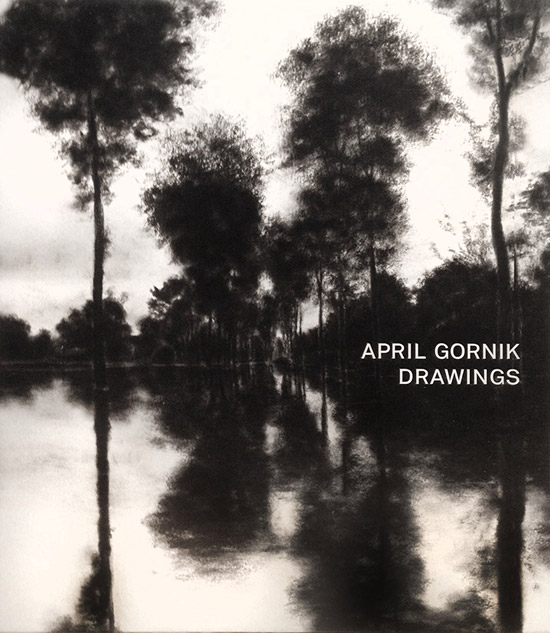Anyone familiar with April Gornik’s art knows she likes to work large—very large.
“My paintings are usually bigger than six feet,” Gornik said in a recent interview. “They occupy a little more than your corporal presence and they meet you like another presence. Hopefully you’ll have a reaction similar to the physical scale.”
Gornik’s massive, ethereal landscapes are not quite of this world and tend by design to evoke introspection, emotion or memory. Her imagery can take viewers to tranquil spots such as still ponds and calming waterfalls, or to seas that churn and expansive golden fields threatened by ominous skies. She also likes to visit the quieter, cathedral-like environment of forests in her work, the towering trunks and sun dappled interiors offering mystery and a maze of possibility.
.
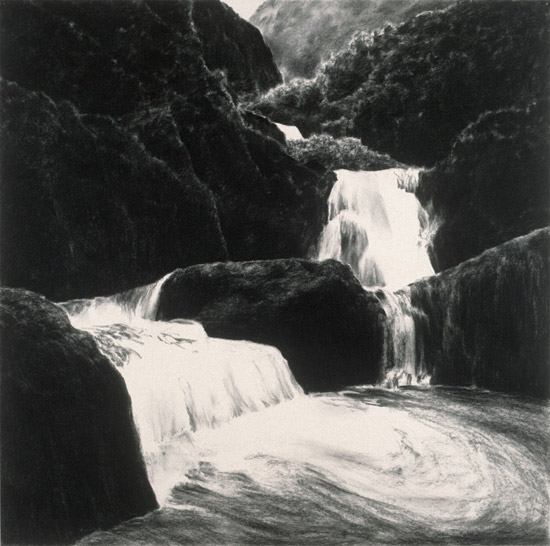
"Turning Waterfall" by April Gornik, 1996.
.

"Storm Rain Light" by April Gornik, 2013. Oil on linen, 88 x 72 inches.
.
These are the elements that draw viewers inside Gornik’s paintings. And although these same elements are included in her landscape drawings of similar subjects, the drawings are done on an entirely different scale.
“I hate working on three- by four-foot paintings,” Gornik said. “They feel like a window, but they don’t have the right intimacy factor.But for drawings, that size has felt great to me.”
Gornik suspects the difference has to do with the application of the different mediums—paint versus charcoal.
“It’s the hand,” she explained. “The brush leaves a mark that’s different than charcoal. Charcoal is more like finger-painting, you’re mark making with pieces of charcoal the size of your finger or smaller. It feels more direct.”
.
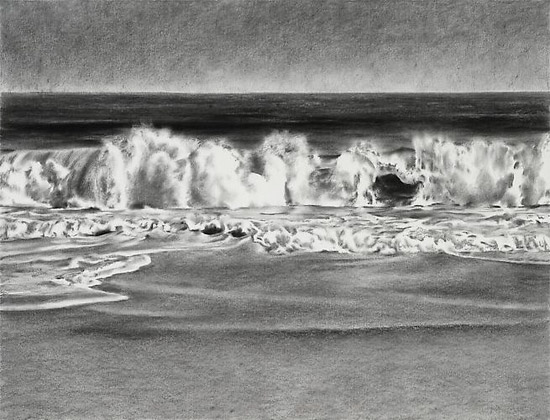
"Breaking Waves" by April Gornik, 2014. Charcoal on paper, 38 x 50 inches.
.
“People come into the studio and think a charcoal drawing is a photograph. It's a nice compliment they think they’re giving me, but they're not seeing the mark as a unique feature—and the mark is the power of what an image can do or be,” she added. “Maybe it’s the mediation of the hand that makes the scale function differently. The presence of the hand in charcoal drawings is critical, and to me, apparent. That’s the closest I can come to explaining why.”
.

"Edge of the Pond" by April Gornik, 1999.
.
A wide range of Gornik’s work is on display this spring, both in a solo show at Danese/Corey Gallery in New York City where a dozen of her large-scale paintings and charcoal drawings are on view through May 31 as well as in a new book, “April Gornik: Drawings” just released by FigureGround Press and distributed by D.A.P.
.

Installation view of April Gornik's work at Danese/Corey Gallery, NY.
.

Installation view of April Gornik's work at Danese/Corey Gallery, NY.
.
A fully illustrated catalogue also accompanies the exhibition. It is available online, through the gallery website or www.blurb.com. On May 29, the artist will sign copies of “April Gornik: Drawings” in an event at Danese/Corey from 5 to 7 p.m.
For Gornik, who lives and works at a studio deep in the woods near Sag Harbor, N.Y. the book is literally a labor of love, a birthday gift from her husband, painter Eric Fischl. The 200 plus charcoal reproductions included in the book represent an extensive period in Gornik’s career, from 1984 to present.
“Eric and I put it together and we worked with designer Lorraine Wild,” Gornik said. “She just did a fantastic job setting it up.”
“It’s a very meditative and beautifully printed book,” she continued.“The images move in one direction then go in another. It’s like a wave action—contemplative and surprising so it’s not stuck in one thing.”
.
.
In addition to the imagery, “April Gornik: Drawings” includes essays by Steve Martin (a collector of Gornik’s and Fischl’s work), and artist Archie Rand, as well as an interview by Lawrence Weschler exploring Gornik’s approach in the studio and in life.
Interestingly enough, also included with the book is an iTunes download of “For April,” a classical composition for piano and cello written by composer and pianist Bruce Wolosoff, a friend who, at Fischl’s request, created the music based on Gornik’s work.
.

The composition "For April” by Bruce Wolosoff while in process in his Shelter Island studio. The work was inspired by an April Gornik drawing.
.
“It was Eric’s idea,” Gornik confessed. “It seemed like a strange idea to me. Then I started getting pictures from Bruce with his piano and a reproduction of one of my drawings propped up on the music stand.”
“It turned out to be this great piece—it’s beautiful and inspired by my drawing of the woods.”
.

"The Woods" by April Gornik, 2006.
.
Though Gornik can’t say why Wolosoff choose one of her forest drawings as his inspiration, she finds it telling, given the fact that she, too, has spent a great deal of time lately contemplating her own attraction to the subject matter—which is well represented in her book.
She suspects it may have something to do with having arrived at middle age, and referenced a quote from Dante in support of this idea: “Midway upon the journey of our life, I found myself within a forest dark, for the straightforward pathway had been lost.”
“Am I halfway in the woods or out of the woods?” she mused. “That’s what I’m always asking.”
The forest views not only speak to Gornik’s own reflections on life at the moment, she finds the subject matter also lends itself well to charcoal, which in many ways embodies different facets of the forest.
.

"Light Falling Through Trees" by April Gornik, 2014. Charcoal on paper, 36.25 x 50 inches.
.
“Charcoal seems like the perfect medium for the forest,” she said. “Charcoal wants to shed. The nature of it is to fall apart and get on other things. It has this kind of essential quality of something that’s dissolving and leaving traces of itself. It’s unlike ink or oil paint. That crumbling quality embeds into paper beautifully and becomes fixed.
“That’s its dichotomous nature, falling apart and aggressive at the same time,” she added. “Just like the tree trunks are solid and leaves are effervescence as they fall off.”
.
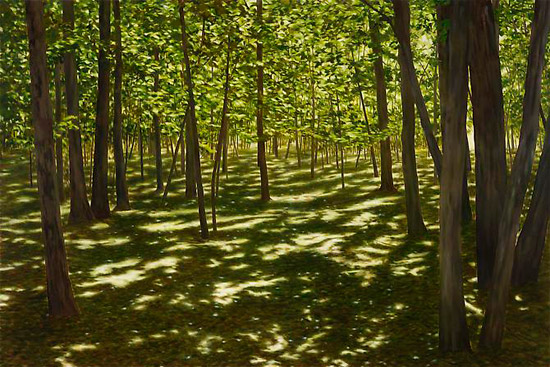
"Green Shade" by April Gornik, 2012. Oil on linen, 72 x 108 inches.
.
There is also something eerily familiar in Gornik’s charcoal renderings of forests that takes viewers even further into their own emotional core than her paintings of similar subjects. It’s sort of like looking back at ancient history and feeling that you’ve been there many times before.
Gornik thinks she knows why.
“The way I make forests, in addition to the black and white aspect, which is like memory, invariably I’m making egresses and ingresses,” the artist said. “But the way in and the way out is not that defined.”
“Therein lies the reference to memory,” she said.“What you do or don’t choose, or are able to remember, what direction you take, the value of where you go and how you can be surprised by going the wrong way by accident.”
.

"Snowfall" by April Gornik, 2014.
.
Like memory, Gornik finds that the act of drawing or painting itself is also full of accidents and indirect uncontrollable circumstances.
“All of that remains in a painting or drawing after you’re done making it,” she said. “It’s a deep thing that lives in the painting and other people can see it. It might feel like nostalgia or memory, but it’s even more complicated and essential to the medium than that.”
.
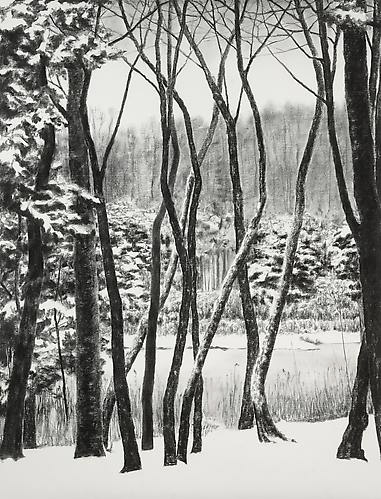
"Snow Stillness" by April Gornik, 2014. Charcoal on paper, 50 x 38 inches.
.
Which leads to questions about interpretation and presentation. Because the presence of the artist’s hand is so vital to delving deeply into the places offered in Gornik’s charcoal imagery, it’s natural to ask how those images translate when they are presented as reproductions in a book.
.
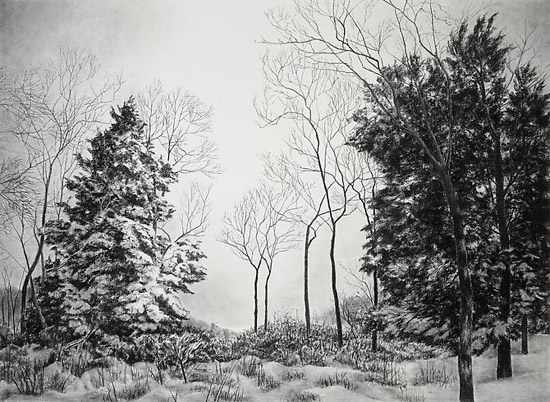
"Winter Light" by April Gornik, 2014. Charcoal on paper, 30.5 x 50 inches.
.
“In any reproduction you’re missing something,” she conceded. “But we did as much as we could to use paper that revealed a lot of detail in the drawings and a straightforward printing approach to make them accessible and present.”
“They’re smaller and the scale is different, but the way a book gathers something is important,” she said. “I still think it’s a more beautiful record than of an image you might find online.”
.

April Gornik. Photo by Ralph Gibson.
.
BASIC FACTS: “April Gornik: Recent Paintings and Drawings” is exhibited through May 31, 2014 at Danese/Corey Gallery, 511 West 22 Street, New York, NY 10011. A Book Signing for “April Gornik: Drawings” will be held at the gallery on May 29 from 5 to 7 p.m. www.danesecorey.com.
In the Hamptons, April Gornik currently has one work on view through June 18 at the Sag Harbor Whaling & Historical Museum made for the whale-centric exhibition "A Whale of A Show".
Information on April Gornik can be found at www.aprilgornik.com.
To hear "For April" by Bruce Wolosoff, click here.
________________________________
Copyright 2014 Hamptons Art Hub LLC. All rights reserved.

